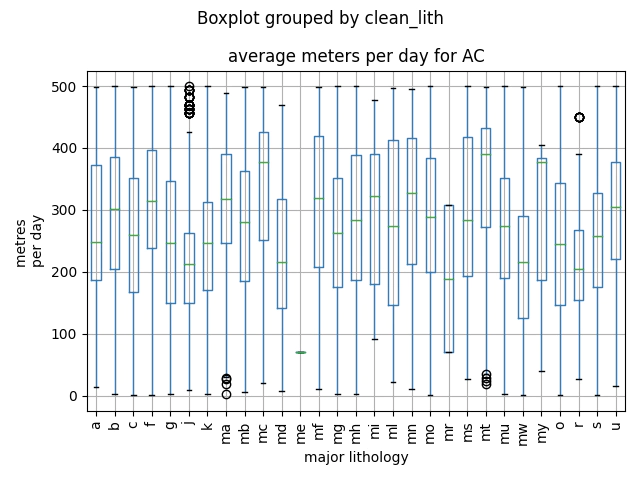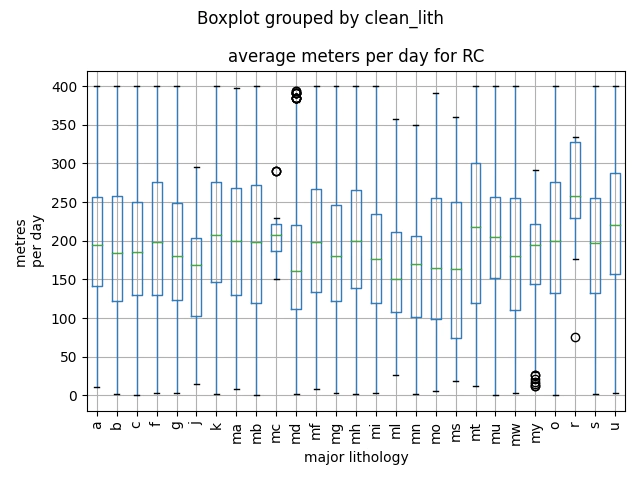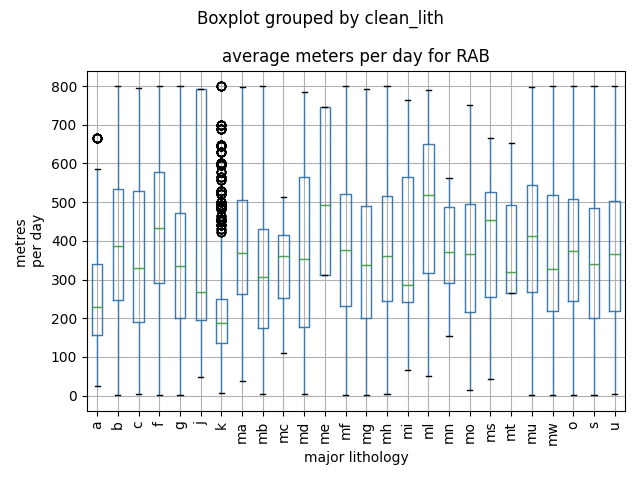drilling metres per day
- 4 minutes read - 691 wordsFor any one doing drill planning taking a guess at how long it will take to complete a drill program is one of the more interesting exercises.
If you are luckly you look at last years drilling and use those numbers in the current estimate.
But for people who:
- Don’t have last years drilling
- Are drilling some where totally new
You can skip to the results from here:
Or you should read the important caveats here.
I have done my best to clean the data out of the WAMEX mddb database by removing non-physical drill metres totals, for example where multiple days drilling were captured as a single day, multiple rigs worth of drilling were captured as a single rig and have kept the analysis to AC, RC and RAB because they tended to have the cleanest and most data.
Of course there is always some level of error that creeps in mostly due to trying to read the approximately 10,000 different date formats for example todays date 1st February 2023 would be in the WAMEX database as a few different formats (44958, 01/02/2023, 02/01/2023, 02:01:2023, 20230201,01022023) and with a little cross referencing I think that I solved ~95% of them. Also mapping the 300 different ways to say drill start date.
The lithological codes are taken from the GSWA 500k interp bedrock, so of course if there is significant amounts of cover before getting to bed rock that will skew the results.
Most of the drilling in WA is centred on well known areas, which does make the extrapolation of drilling performance slightly difficult. I first considered creating a machine learning model to predict expected drill metres across all of WA but then I realised that the data just doesn’t support that level of model, why?
The data available is highly dependent on confounders such as:
- travel time between holes
- rig maintenance
- condition of the drill pads
- distance to water
- distance to camp
- driller
Having looked at a lot of drill productivity data over the years and having access to each item in the list above. A good driller is going to get consistently more metres than you would expect. The reason I think is that good drillers don’t focus on the drilling (up and down round and round) only but the whole support system around achieving their metre target.
What does this mean in simple terms, a good driller is organised and well planned they won’t be running out of water half way through the hole and they will be planning to maximise their active time by controlling the time wasted in moving to the next hole, waiting on the geo, waiting on survey, etc.
Air Core

Reverse Circulation

RAB

Diamond

Rock Type reference
| RockTypeID | ROCKTYPE | |
|---|---|---|
| 0 | a | igneous ultramafic intrusive |
| 1 | b | igneous mafic volcanic |
| 2 | c | sedimentary other chemical or biochemical |
| 3 | d | igneous foid-bearing intrusive |
| 4 | e | igneous melilitic |
| 5 | f | igneous felsic volcanic |
| 6 | g | igneous granitic |
| 7 | i | igneous lamproites |
| 8 | k | sedimentary carbonate |
| 9 | l | igneous feldspathoid-bearing volcanic |
| 10 | ma | meta-igneous ultramafic intrusive |
| 11 | mb | meta-igneous mafic volcanic |
| 12 | mc | metasedimentary other chemical |
| 13 | md | metasedimentary siliciclastic |
| 14 | m | metamorphic |
| 15 | mf | meta-igneous felsic volcanic |
| 16 | mg | meta-igneous felsic intrusive |
| 17 | mk | metasedimentary carbonate |
| 18 | mo | meta-igneous mafic intrusive |
| 19 | mr | meta-igneous felsic |
| 20 | mu | meta-igneous ultramafic volcanic or undivided |
| 21 | mv | meta-igneous volcanic |
| 22 | mw | meta-igneous mafic |
| 23 | mj | metasomatic |
| 24 | mz | metamorphosed hydrothermal |
| 25 | o | igneous mafic intrusive |
| 26 | p | igneous kimberlite |
| 27 | r | igneous carbonatite |
| 28 | s | sedimentary siliciclastic |
| 29 | u | igneous ultramafic volcanic |
| 30 | w | igneous kalsilitic |
| 31 | y | igneous lamprophyres |
| 32 | z | hydrothermal |
| 33 | my | metamorphic protolith unknown: fault rock |
| 34 | mn | metamorphic protolith unknown: gneiss |
| 35 | me | metamorphic protolith unknown: granofels/hornfels |
| 36 | mp | metamorphic protolith unknown: impactite |
| 37 | ms | metamorphic protolith unknown: schist |
| 38 | mi | metasedimentary other chemical: meta-iron formation |
| 39 | ml | metasedimentary siliciclastic: pelite |
| 40 | mt | metasedimentary siliciclastic: psammite |
| 41 | mh | metasedimentary siliciclastic: psammite and pelite; interlayered |
| 42 | mx | metasedimentary siliciclastic: psephite |
| 43 | mm | metasedimentary siliciclastic: semipelite |
| 44 | mq | metasedimentary siliciclastic: semipsephite |
Thanks,
Ben.